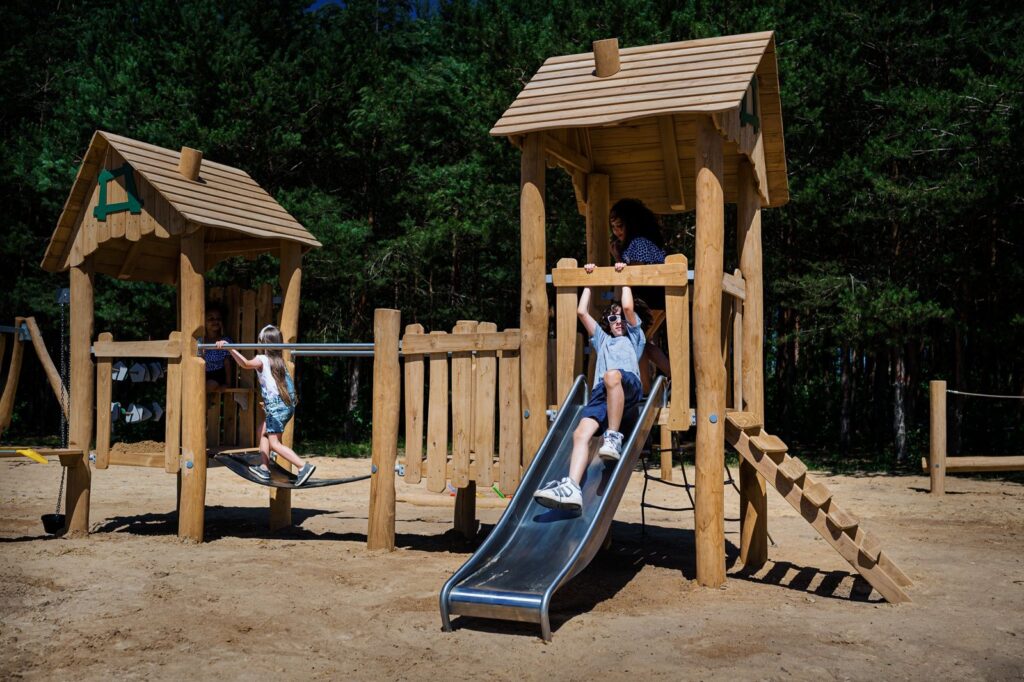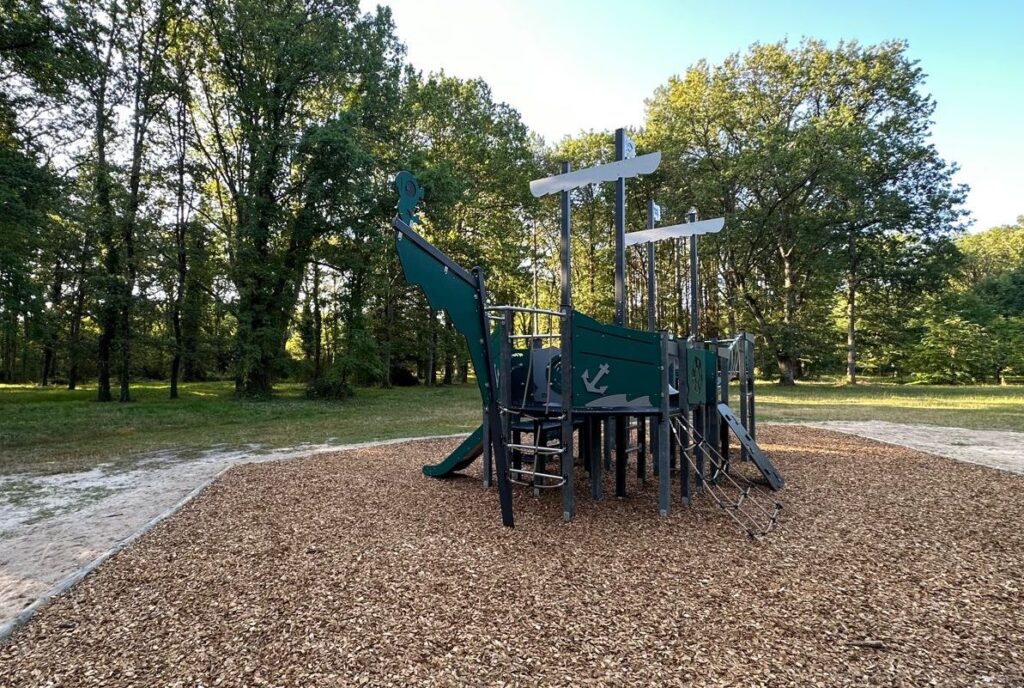
Playgrounds have long been cherished as havens where children can freely express their energy, nurture social aptitude, and enhance physical abilities. Nevertheless, amidst the increasing consciousness of environmental issues, it becomes imperative to reconsider the approach to designing and constructing these areas. The emergence of eco-friendly playgrounds presents a pivotal solution, providing advantages not solely for the environment but also for the health and overall well-being of our children. This article aims to look at the importance of eco-friendly and recycled playgrounds, as well as to delve into actionable steps for their creation. By embracing environmentally sustainable practices in playground design, we not only contribute to the preservation of our planet but also create safer, healthier, and more enjoyable spaces for our children to thrive in.
Health and Well-being:
In the realm of children’s health, the emphasis on eco-friendly playgrounds extends beyond avoiding immediate dangers. Conventional playground materials, laden with harmful chemicals like lead and phthalates, can result in chronic health issues such as respiratory problems and developmental issues. Recycled playgrounds, crafted from non-toxic materials, act as sanctuaries that shield children from the adverse effects of prolonged exposure to hazardous substances. By prioritizing health and well-being through the use of eco-conscious materials, we not only safeguard the physical health of our children but also nurture an environment that supports their overall development, fostering a generation that grows up in harmony with nature.
Environmental Sustainability:
Traditional playgrounds are notorious for their high energy consumption, with artificial lighting, electronic play components, and other amenities adding to the overall environmental burden. This energy demand often relies on non-renewable sources, further intensifying the ecological strain.
Eco-friendly playgrounds, on the other hand, prioritize environmental sustainability through a holistic design approach. These playgrounds strive to minimize their ecological footprint by utilizing sustainable materials like recycled plastics and reclaimed wood. By repurposing materials that would otherwise end up in landfills, eco-friendly playgrounds contribute to the reduction of waste and promote a circular economy.
Renewable energy sources play a pivotal role in the eco-friendly playground vision. Integrating solar panels into the playground infrastructure harnesses the power of the sun to generate clean energy. This not only reduces dependence on non-renewable energy but also sets an example for sustainable practices, educating children about the potential of renewable resources.
Waste reduction strategies further distinguish eco-friendly playgrounds. Incorporating recycling bins, composting areas, and designing structures with a focus on durability and longevity all contribute to minimising the environmental impact throughout the lifecycle of the playground.

Connection with Nature:
Nature plays a crucial role in a child’s development, fostering creativity, reducing stress, and promoting overall well-being. Eco-friendly playgrounds are designed to enhance the connection between children and nature, providing a more enriching play experience. Natural elements like wood, rocks, and water features can stimulate a child’s senses and encourage exploration.
Educational Opportunities:
Eco-friendly playgrounds offer unique opportunities for environmental education. By incorporating features like rain gardens, recycled materials, and energy-efficient installations, children can learn about sustainable practices in a hands-on and engaging manner. These playgrounds serve as living classrooms, instilling a sense of responsibility and environmental stewardship from an early age.
Creating Eco-Friendly Playgrounds
Sustainable Materials:
The choice of materials is pivotal in creating an eco-friendly playground. Opt for sustainable materials such as recycled plastic, reclaimed wood, and metal sourced from responsible suppliers. These materials not only reduce the demand for virgin resources but also minimize the environmental impact associated with extraction and processing.
Natural Landscaping:
Incorporating natural elements into the playground design can enhance its eco-friendliness. Use native plants and trees to create shade, biodiversity, and a more visually appealing environment. Native plants are well-adapted to local conditions, requiring less water and maintenance.
Energy Efficiency:
Implement energy-efficient solutions in playground design. Solar panels can be integrated into structures to generate clean energy, powering lights and other installations. LED lighting is an energy-efficient alternative that can enhance safety during evening play.
Water Conservation:
Implement water-saving measures such as permeable surfaces and rain gardens. Permeable surfaces allow rainwater to penetrate the ground, reducing runoff and preventing soil erosion. Rain gardens not only capture and filter rainwater but also provide an attractive and educational element for children.
Recycled Materials:
In the pursuit of crafting eco-friendly playgrounds, the strategic use of recycled materials emerges as a cornerstone for minimizing environmental impact. Opting for recycled rubber in safety surfaces not only enhances shock absorption but also diverts used tyres from landfills, addressing a significant environmental concern. This sustainable choice not only repurposes existing materials but also mitigates the environmental burden associated with the production of new rubber.
Similarly, incorporating recycled plastic in play structures transforms discarded plastic items into vibrant and engaging components. This approach not only diminishes the accumulation of plastic waste but also reduces the demand for virgin plastic production, which is notorious for its detrimental effects on marine life and ecosystems.
Reclaimed wood, chosen for seating and structural elements, further underscores the commitment to sustainability. By giving new life to wood from salvaged sources, eco-friendly playgrounds contribute to the preservation of forests and biodiversity while avoiding the environmental costs associated with fresh timber harvesting. The recycled playgrounds by Koochie Global exemplify sustainability as they recycle wood, plastic and textile waste to create the playground. This goes a long way in restoring nature’s ecological balance as a means of mitigating pollution and encouraging sustainable forest management.

Inclusive Design:
An eco-friendly playground should be designed to be inclusive and accessible to all children. Inclusive design considers the diverse needs of children, including those with disabilities, ensuring that everyone can enjoy the playground experience. This approach fosters a sense of community and equality.
Community Engagement:
Engage the community in the planning and development of eco-friendly playgrounds. Gather input from parents, educators, and local residents to ensure that the playground meets the needs of the community. Involving the community in the process fosters a sense of ownership and responsibility for the playground’s upkeep.
As our society becomes increasingly conscious of environmental issues, the need for eco-friendly playgrounds becomes more evident. These playgrounds offer a host of benefits, from promoting children’s health and well-being to fostering environmental education and stewardship. By choosing sustainable materials, incorporating natural elements, and embracing energy-efficient solutions, we can create playgrounds that not only provide a safe and enjoyable space for children but also contribute to a greener and more sustainable future. As manufacturers of playground equipment, let us take the lead in building a brighter tomorrow for our children and the planet.
